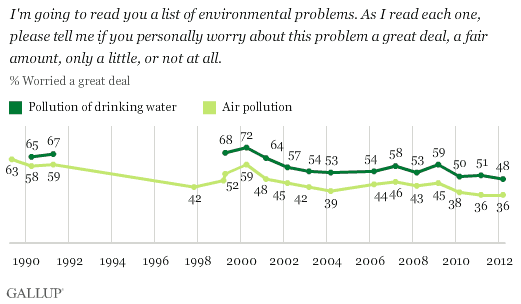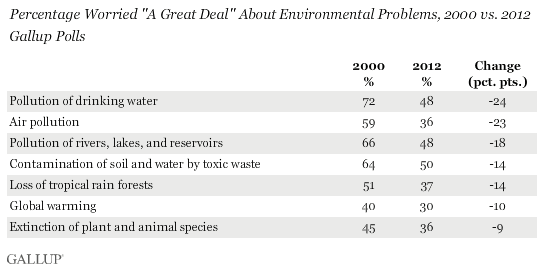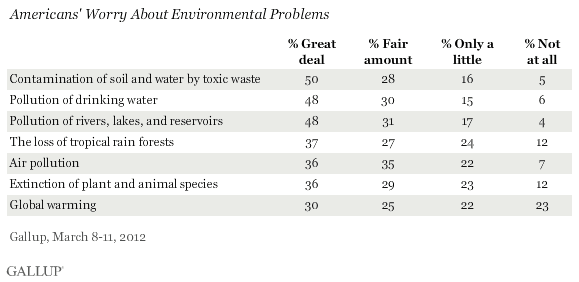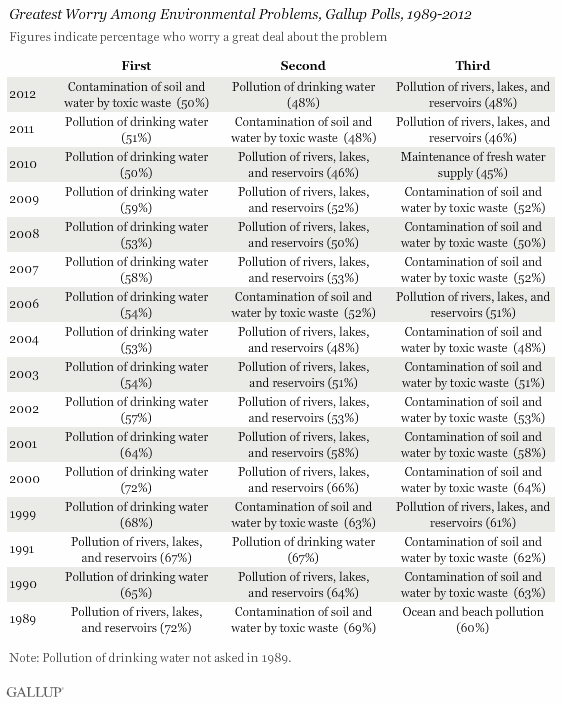PRINCETON, NJ -- Americans currently express record-low concern about both air pollution and pollution of drinking water. Thirty-six percent say they worry a great deal about air pollution and 48% about pollution of drinking water. Both figures are down more than 20 percentage points from the year 2000.

These results are based on Gallup's annual Environment poll, conducted March 8-11. The trends are part of a broader decline in worry about environmental threats documented in the poll.
ÓÅÃÛ´«Ã½asked Americans to say how much they worry about each of seven environmental problems. All show significantly less worry today than in 2000, when worry was at or near its high point for each item. The declines in concern about drinking-water pollution and air pollution are the largest for the problems included in this year's poll.

More broadly, worry about the seven issues is below the historical average for each. Most of the trends date back to 1989.
Concern about these environmental problems is down among most major subgroups since 2000. Across the seven items, the percentage worried a great deal is down an average 16 percentage points among Republicans, 18 points among independents, and 13 points among Democrats.
Americans Worry Most About Water Contamination, Least About Global Warming
On a relative basis, Americans tend to worry more about environmental threats to the nation's water supplies than those that affect other parts of the environment. The highest levels of worry this year are for contamination of soil and water by toxic waste, pollution of drinking water, and pollution of rivers, lakes, and reservoirs.
Concern about global warming is lowest of the seven environmental issues tested, even though it is .

The relative rank order of these environmental issues has generally been consistent over time, with . In fact, the three water concerns in this year's poll have ranked as the top three concerns over any other environmental problems nearly every time they have been asked since 1989. Pollution of drinking water has most often been the top concern.

Implications
Americans' concerns about environmental problems have dropped in recent years, coincident with their and the .
There are two likely explanations for the declining concern. First, Americans about the quality of the environment. Second, the economic downturn has forced Americans to focus more on bread-and-butter economic issues than quality-of-life issues. It may be no coincidence that environmental concern was highest in 2000, when the U.S. was enjoying one of the strongest economies in recent memory, and that environmental concern has reached new lows recently, after the worst financial downturn in the last 25 years.
Survey Methods
Results for this ÓÅÃÛ´«Ã½poll are based on telephone interviews conducted March 8-11, 2012, with a random sample of 1,024 adults, aged 18 and older, living in all 50 U.S. states and the District of Columbia.
For results based on the total sample of national adults, one can say with 95% confidence that the maximum margin of sampling error is ±4 percentage points.
Interviews are conducted with respondents on landline telephones and cellular phones, with interviews conducted in Spanish for respondents who are primarily Spanish-speaking. Each sample includes a minimum quota of 400 cell phone respondents and 600 landline respondents per 1,000 national adults, with additional minimum quotas among landline respondents by region. Landline telephone numbers are chosen at random among listed telephone numbers. Cell phone numbers are selected using random-digit-dial methods. Landline respondents are chosen at random within each household on the basis of which member had the most recent birthday.
Samples are weighted by gender, age, race, Hispanic ethnicity, education, region, adults in the household, and phone status (cell phone only/landline only/both, cell phone mostly, and having an unlisted landline number). Demographic weighting targets are based on the March 2011 Current Population Survey figures for the aged 18 and older non-institutionalized population living in U.S. telephone households. All reported margins of sampling error include the computed design effects for weighting and sample design.
In addition to sampling error, question wording and practical difficulties in conducting surveys can introduce error or bias into the findings of public opinion polls.
View methodology, full question results, and trend data.
For more details on Gallup's polling methodology, visit .
